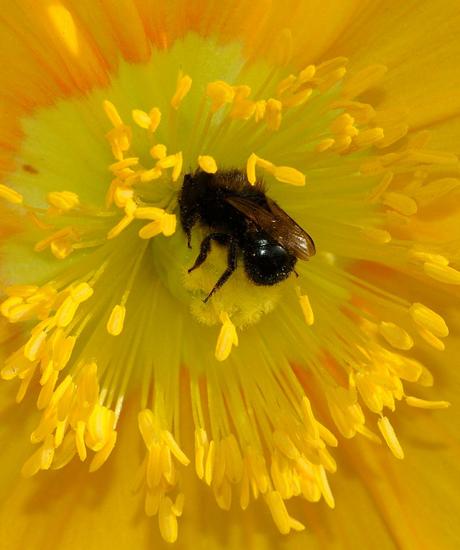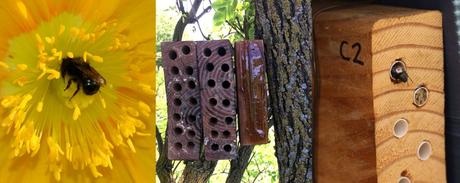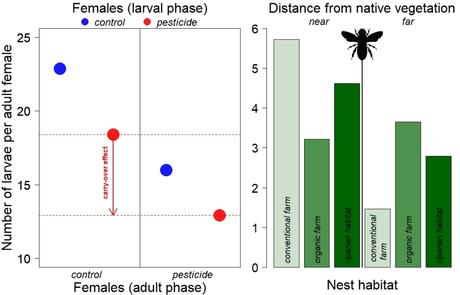Bees are essential for pollination, but their critical function can be perturbed by pesticides. The detrimental effects of those chemicals accumulate through a bee’s life, and become stronger if females cannot collect pollen from wildflowers.

Our childhood experiences partly determine our health, personality, and lifestyle when we are adults, and our experiences accumulate over time. Accumulation also occurs in any living being and can explain why some populations and species adapt to their environments better than others.
Migratory birds are a clear example. Thousands can travel to their breeding grounds after wintering elsewhere, and those coming from regions laden with resources (e.g., food, shelter, water) will have a greater reproductive success than those that migrated from resource-poor regions (1). In ecology, these ‘carry-over’ effects can take place between seasons, but also across the different phases of the life cycle of a plant or animal (2).
From larvae to adults
Clara Stuligross and Neal Williams have studied the carry-over effect of pesticides on the blue orchard bee Osmia lignaria in California (3). Instead of the typical hives constructed by the honey bee (Apis mellifera), solitary blue orchard bees make lines of brood cells with mud partitions, glued into holes and crevices of branches and trunks from fallen trees (see videos here, here, & here).
Within each nest, the mother will deposit an individual egg and a provision of nectar and pollen. The larvae hatches and feeds on this food over winter, and will abandon the nest the following spring to start the cycle again. These authors released 8 young study females and 16 males (sex ratio in natural conditions) in each of 16 flight cages layered with soil planted with common wildflowers.
Prior to release, the plants of half of the cages had been sprayed with a neurotoxic pesticide, and the other half was free of the chemical. And the previous spring, the mothers of half of the study females foraged on plants sprayed with the same pesticide and the other half foraged on uncontaminated plants. This experimental design generated four types of females: (i) exposed to pesticide as larvae, (ii) adults or (iii) both, and (iv) never exposed.

At the end of the experiment, fertility peacked (23 larvae/female) when bees were never exposed to the pesticide through their entire life cycle. But such fertility decreased twice as much if females were exposed to the pesticide only as larvae (5 larvae/female fewer than in the absence of the neurotoxin) than when they were exposed as larvae and adults (10 larvae/female fewer).
So, the magnitude of the impact of a pesticide on a bee’s fertility accumulates from one phase of the life cycle to the next, and is milder if exposure occurs only in the larval phase when the nervous system is still in development, with fewer neurotoxic receptors than that of the adults (3, 4).
Landscape also matters
In California’s countryside, blue orchard bees enjoy a diverse landscape with organic farms and native vegetation (chaparral, oak woodland, riparian habitat) interspersed with conventional farms that routinely use agrochemicals.
In this mosaic, Williams found that when conventional farms are spatially close to patches of native vegetation, the pesticide-driven decline in fertility is mitigated because bees can collect a fraction of pollen from wildflowers free of agrochemicals (5).
But where farms are far away from native vegetation, bee fertility in organic farms and riparian habitats increases four-fold relative to conventional farms essentially because, in the latter, the little insects are constrained to forage on plants sprayed with pesticide.

Twilight of the tiny
Neurotoxic pesticides disrupt the growth, physiology, and behavior of bees (6, 7). If those pernicious effects accumulate, not only from larvae to adults, but also generation by generation, the health of a population will be a reflection of its ‘chemical history’ since it colonised a territory.
The worst scenario for a bee is an extensive monoculture periodically treated with pesticides and isolated from wild, native vegetation. There, bee populations are most likely to fall into population decline, leading to local extinctions if deaths outnumber births.
Not surprisingly, terrestrial ecosystems are witnessing a global demise of insects partly due to the (over)use of agrochemicals (8, 9). But … the pollination of orchards and farms, riparian habitats, grasslands, and forests invariably relies on bees and hundreds of thousands of other arthropod species, with gigantic ecological and economic implications (10-12).
Local farmers must diversify their practices, foster the natural control of disease outbreaks, and facilitate nutrient cycling in the soil and the access of pollinators to wildflowers (13). By fertilising flowers that will become fruit, the agricultural sector and the national and regional governments that regulate it must appreciate that insects work for us for free and their benefit is ours too.
A Spanish version of this blog was published by the journal Quercus in April 2022.
References
- Harrison XA et al. (2011). Carry-over effects as drivers of fitness differences in animals. Journal of Animal Ecology 80: 4-18
- O’Connor CM et al (2014). Biological carryover effects: linking common concepts and mechanisms in ecology and evolution. Ecosphere 5: 1-11
- Stuligross C & Williams, NM (2021). Past insecticide exposure reduces bee reproduction and population growth rate. Proceedings of the National Academy of Sciences of the USA 118: e2109909118
- Nicholls E et al. (2017). Larval exposure to field-realistic concentrations of clothianidin has no effect on development rate, over-winter survival or adult metabolic rate in a solitary bee, Osmia bicornis. PeerJ 5: e3417
- Williams NM & Kremen, C (2007). Resource distributions among habitats determine solitary bee offspring solitary bee production in a mosaic landscape. Ecological Applications 17: 910-921
- Desneux N, Decourtye, A & Delpuech, JM (2007). The sublethal effects of pesticides on beneficial arthropods. Annual Review of Entomology 52: 81-106
- Cabirol A & Haase, A (2019). The neurophysiological bases of the impact of neonicotinoid pesticides on the behavior of honeybees. Insects 10: 344
- Wagner DL et al. (2021). Insect decline in the Anthropocene: death by a thousand cuts. Proceedings of the National Academy of Sciences of the USA 118: e2023989118
- Sánchez-Bayo F & Wyckhuys, KAG (2019). Worldwide decline of the entomofauna: a review of its drivers. Biological Conservation 232: 8-27
- Potts SG et al. (2010). Global pollinator declines: trends, impacts and drivers. Trends in Ecology and Evolution 25: 345-353
- Millard J et al. (2021) Global effects of land-use intensity on local pollinator biodiversity. Nature Communications 12: 2902
- Bennett JM et al. (2020). Land use and pollinator dependency drives global patterns of pollen limitation in the Anthropocene. Nature Communications 11: 3999
- Potts SG et al. (2016). Safeguarding pollinators and their values to human well-being. Nature 540: 220-229

